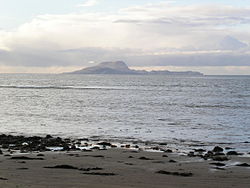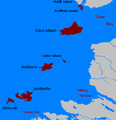Clare Island
| Clare Island Gaelic: Oileán Chliara | |
 Clare Island from Clew Bay | |
|---|---|
| Location | |
| Location: | 53°48’8"N, 9°59’10"W |
| Area: | 3,949 acres |
| Highest point: | 1,516 ft |
| Data | |
| Population: | 168 (2011) |
Clare Island (Oileán Chliara in Irish) is a mountainous island guarding the entrance to Clew Bay in County Mayo, Ireland. It is famous as the home of the pirate queen Gráinne O'Malley. Approximately 168 people live there as of 2011.
South-west of Clare Island lie the uninhabited Caher Island and the inhabited Inishturk.
History
Through the Middle Ages, Clare Island was part of the lands of the O'Malley family. The ruins of an O'Malley tower-house, known as Granuaile's Castle because of its most famous resident, are close to the pier at the eastern edge of the island. Clare Island Abbey near the south coast of the island was founded by the O'Malleys and contains the O'Malley Tomb, a possible burial site of Gráinne O'Malley. The Abbey is known for its rare medieval roof paintings. In 1588 a ship from the Spanish Armada was wrecked on Clare Island and its men were killed by the O'Malleys.
A very prominent landmark of the island is the Clare Island Lighthouse, established by John Denis Browne, the 1st Marquess of Sligo, in 1806. On 29 September 1813 a fire, caused by careless disposal of the oil-lamp wicks, destroyed part of the tower and the lantern. The rebuilt light was ready in 1818. In 1834 the tower was struck by lightning. After 159 years of faithful service the lighthouse was taken out of service on 28 September 1965, replaced by the modern Achillbeg Island lighthouse on the south side of Achill Island.
Clare Island Lighthouse has been refurbished and is now an upmarket guesthouse.
Fauna and Flora
Between 1909 and 1911, the Belfast naturalist Robert Lloyd Praeger led an exhaustive biological survey of the island, the Clare Island Survey, which was unprecedented at the time and served as a template for future studies. A new study of the Island was made in 1990 to 2005 and the results were published in six volumes, the last of which was published in 2007.[1] They are available for purchase from the Royal Irish Academy. This is reputedly the only survey of its kind in Europe and is serving as a model for measuring the effects of climate change on environment.
Algae
Three species of freshwater red algae have been recorded from Clare Island: Batrachospermum atrum (Hudson) Harvey, B. turfosum Bory and Lemanea fucina Bory.[1]
Transportation and Infrastructure
Clare Island is accessible by daily ferry services from Roonagh Pier near Louisburgh. The return trip costs €15 and a map of the island is provided with the ticket. The island has a hostel, a few bed and breakfasts and a yoga and meditation centre. Maps are available for walkers and hill-walkers. The island is also suitable for exploration by bicycle, which can be rented in Glen (beside the pier) for €10 for the day.
The island has its own primary school and a post office. Children go to the mainland for post-primary (secondary school) education. The harbour, located on the SE of the island, offers good shelter in all winds with West in them, but is totally opened to easterly winds. The piers are not suitable for yachts to come alongside, but in the summer, Mayo county council maintains a number of moorings for visiting yachts. The innter harbour dries out with a sandy bottom.
Culture
The island features in a song by the Irish folk-rock band, the Saw Doctors from their 1996 album, Same Oul' Town. In the song, the band immortalise the island. It is described as a haven from hectic city life.
Clare Island is the setting for Bob Quinn's film "Budawanny" (1987). Bob Quinn also shot a documentary on Clare Island ("The island") in 1966.[2]
Gallery
-
Post office c. 1900
-
Granuaile's Castle
-
The optic from the Clare Island lighthouse now on permanent rotating display at The World of Glass gift shop, St Helens, Lancashire
-
Islands off County Mayo
Click for larger view -
Visiting Clare Island.
-
Visiting Clare Island.
-
Clare Island as seen from Inishturk
References
- ↑ 1.0 1.1 Ed. Guiry, M.D., John, D.M., Rindi, F. and McCarthy, T. K. New Survey of Clare Island Volume 6: The Freshwater and Terrestrial Algae. Royal Irish Academy ISBN 978-1-904890-31-7
- ↑ http://www.conamara.org/
Outside links
| ("Wikimedia Commons" has material about Clare Island) |
- Information site on Clare Island, updated regularly with news and events
- Another information site on Clare Island, maintained by an islander
- In this series of podcasts on Mayo's Heritage, an excerpt can be heard from Ger Reidy's visit to Clare Island as part of his Heritage Tour of Clew Bay







